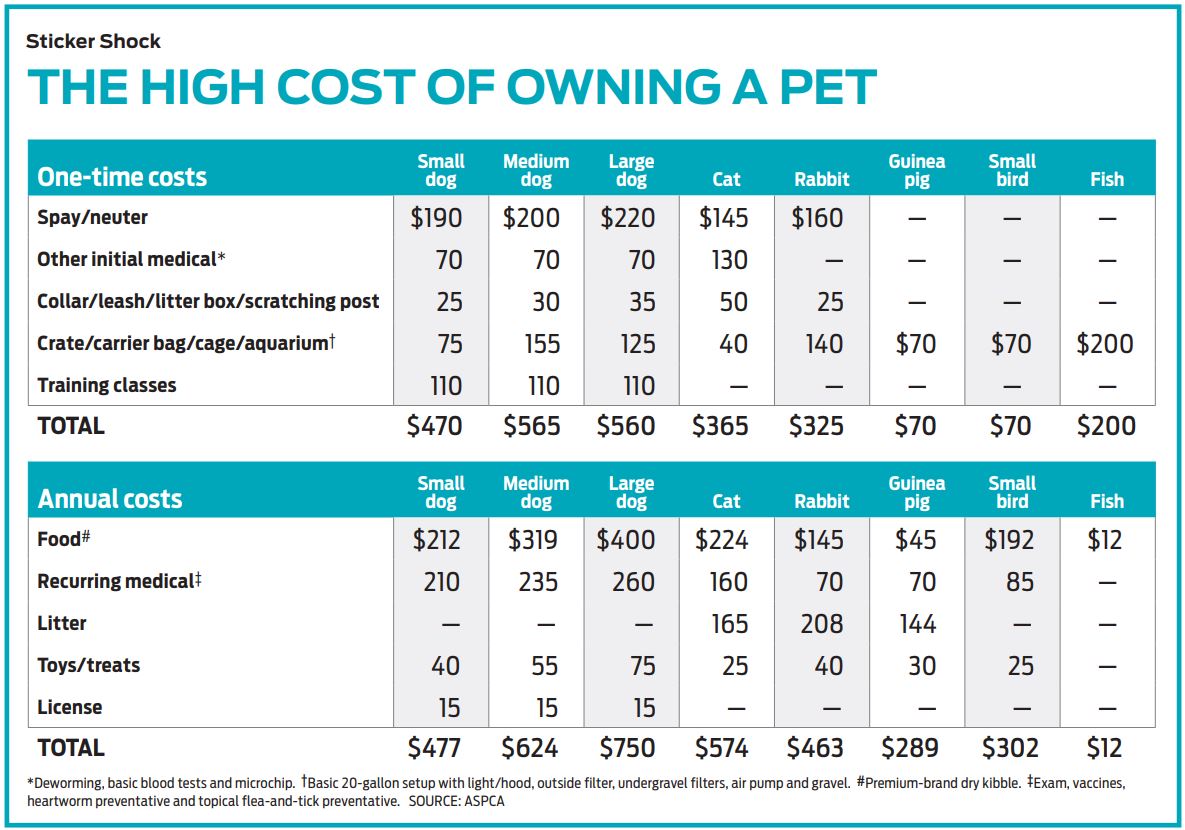Trim the Cost of Pet Care
Your furry friends can run up a big tab over their lifetime, but we'll show you how to keep expenses in check.
It happened in a flash. One minute Dan Perlowitz of West Orange, N.J., had his dog Gracie's leash in hand, and the next she had broken away and run onto a nearby highway. She was hit by one car and rolled over by another, but, thankfully, she suffered only a broken rib and a concussion and healed with no complications.
The bill for Gracie's hospital stay and veterinary care–$4,063–could have been painful, too. But Dan and his wife, Jamie, had purchased pet insurance after adopting Gracie in 2014. "Because we didn't know much about her past or what medical issues she might have, we wanted to have the insurance just in case," says Dan. The policy from Healthy Paws, which costs $48 a month, paid for all but $659 of the tab, after excluding certain charges, applying a $100 deductible and a 10% co-payment.
In 2016, U.S. pet owners spent $66.8 billion on their pets, compared with $38.5 billion in 2006, according to the American Pet Products Association. Almost half of that was for food, almost one-fourth for vet care, and just over one-fifth was for supplies and over-the-counter medicine. But there are smart ways to save while providing the best care.
From just $107.88 $24.99 for Kiplinger Personal Finance
Become a smarter, better informed investor. Subscribe from just $107.88 $24.99, plus get up to 4 Special Issues

Sign up for Kiplinger’s Free Newsletters
Profit and prosper with the best of expert advice on investing, taxes, retirement, personal finance and more - straight to your e-mail.
Profit and prosper with the best of expert advice - straight to your e-mail.
Mutt or purebred?
The Perlowitzes found Gracie, a Labrador retriever mix, at an adoption event held by a rescue group at a local pet store. The fee was $350, and Gracie was spayed and up to date on her shots.
The assumption has long been that mixed-breed pets are healthier and thus less expensive to own than purebred ones, which often suffer from inherited disorders. But a study published in the Journal of the American Veterinary Medical Association found no difference between purebred dogs and mixed-breed dogs in more than half of the 24 genetic disorders that the study considered, although purebred dogs showed a higher incidence of some disorders. Bottom line, says the AVMA: Both mixed breeds and purebreds may have an inherited disorder. (The AVMA has guidance on choosing choosing dogs, cats and other types of pets as well.)
Buying from a pet store is rarely a good idea. The animals often come from puppy mills or kitten factories, and many jurisdictions in nearly half of the states have banned their retail sale.
If you have your heart set on, say, a Lab or a French bulldog, you'll most likely buy one from a breeder at a cost of thousands of dollars. Ask the breeder whether tests have been performed on the dog's parents or offspring to ensure they aren't carrying genetic diseases common to the breed. To find registered breeders, use the search tool of the American Kennel Club or the Cat Fancier Association).
Buying from a pet store is rarely a good idea. The animals often come from puppy mills or kitten factories, and many jurisdictions in nearly half of the states have banned their retail sale. Shelters receive animals from owners, animal-control authorities and people who have found lost or abandoned pets. Rescue organizations often take pets from shelters where the animals may be euthanized, or from owners who can't keep them but want to ensure they're not put down.
Adopting a pet from a shelter typically runs from $20 to $350. Most shelter dogs end up there because their owners had to move, had landlord difficulties or couldn't afford to keep them. Adopting an animal from a rescue organization typically costs somewhat more–from $150 to $400–because of the time and resources that volunteers invest before the animal is placed in a home. (If you want to adopt a purebred from a rescue, visit www.akc.org/akc-rescue-network or, for cats, http://cfabreedersassist-rescue.org/rescue.html.)
Whether you're buying from a breeder or adopting from a shelter or rescue organization, the fee often includes the first round of vaccinations and microchipping (a method of identification). The animal may come spayed or neutered.
There are some 10,000 rescue groups in the U.S., and they are underregulated and mostly unsupervised. The risk is that you don't know exactly what you're getting, says Nancy Halpern, a vet and lawyer in Princeton, N.J. To ensure that you're getting a pet from a reputable shelter or rescue, ask your vet for a referral, or look for a well-established shelter that shares its policies with the public and documents the completion of vaccinations and neutering or spaying.
In the 22 states with pet purchase protection laws–sometimes called puppy lemon laws–you may have legal recourse if you must return an animal with a disease or defect to a pet store or a breeder within a certain time after you get it. In New Jersey, for example, pet owners have 14 days to return an animal if it becomes sick or dies from a non-congenital condition, and six months if it has congenital or hereditary defects. The owner typically gets a refund of the purchase price or a replacement as well as the cost of vet fees.
The cost of health care
As more and more pet owners consider their four-legged friends to be part of the family, spending on health care continues to rise. Advances in veterinary medicine are also fueling the increase. Most treatments available to humans–from chemotherapy and radiation to organ transplants and prosthetic limbs–are also available for pets.
Even relatively common pet mishaps and maladies can be costly. Taking your dog to the vet for an ear infection generally costs $100 to $250, while care for a dog's urinary tract infection rings in at about $300. If your dog eats something he shouldn't, you'll be looking at a vet bill of about $1,550, on average. If your cat is yowling in pain from bladder stones, the cost to treat it averages about $1,900. Caring for a pet with, say, a torn ligament or a shattered bone will set you back several thousand dollars–or more, if regular follow-up visits are required.

You can also expect to spend several hundred dollars a year on routine medical expenses, such as vaccinations and heartworm, flea and tick prevention. And other preventive treatments, such as dental cleanings and annual checkups, can add up fast.
If the cost of a vet's treatment plan exceeds your ability to pay, don't hesitate to ask for alternatives that will fit your budget. "A vet's job is to present you with the most comprehensive treatment plan for your pet," says Ocean Isle Beach, N.C., veterinarian Ernie Ward. "But vets can usually be creative when it comes to making concessions–say, holding off on a test or offering affordable alternatives," he says.
The insurance safety net. A small but growing group of pet owners are buying health policies for their pets. Today, about 1.6 million pets in the U.S. have coverage, according to the North American Pet Health Insurance Association–and pet owners have more options for coverage than in years past, with about two dozen brands offering policies. (Most cover only cats and dogs, but Nationwide also sells policies for birds and exotic pets.)
The cost of a policy varies based on the age of your pet, its breed, where you live and the type of coverage you select. But a policy with broad coverage typically costs about $30 to $150 a month for a dog and $10 to $50 a month for a cat.
Most plans cover both accidents and illnesses but usually don't cover routine exams and care, such as annual checkups, dental cleanings and vaccinations. (You can generally add wellness coverage for an additional premium or buy a separate policy.) The policies won't cover preexisting conditions, and some exclude exams or hereditary and congenital conditions, such as hip dysplasia, often seen in some large dog breeds. As with your own health insurance, if your pet is healthy throughout the year, you may not recoup the cost of your premiums. But if your pet suffers from an ongoing health condition or has an accident, the coverage may pay for itself.
When shopping for a policy, carefully review what's covered and what's not. The insurer should clearly spell out the details, including any limitations or exclusions. "To increase the value of your policy, enroll your pets while they're young and before they've been diagnosed with any medical conditions," says Rob Jackson, co-founder of Healthy Paws Pet Insurance and Foundation. Then you are less likely to be denied coverage based on an exclusion for a preexisting condition.
As with other types of insurance, it pays to shop around. Start by asking for recommendations from friends who have coverage or from a local vet, or visit www.petinsurancereview.com or www.petinsurancequotes.com for an overview of offerings. And you may be able to buy discounted coverage through your employer. According to the Society for Human Resource Management, 10% of employers offered pet insurance as a benefit in 2017.
When you're comparison shopping, among the first things you'll want to check is how much of the vet's tab your insurer will pick up. Reimbursement rates typically range from 60% to 90%, with pricier premiums for the best coverage. Make sure you understand the deductibles and maximums. Deductibles can be annual or per incident, and plans may have maximums that they'll pay for each incident, per year or over the pet's lifetime.
After you enroll, you'll usually have a waiting period of 10 to 30 days before coverage kicks in. Unlike most human health insurance, pet insurers don't have a network of providers, so you can visit any licensed veterinarian. But you'll generally need to pay the vet for the cost of care up front, then submit your claim for reimbursement.
Save on meds. There's one more line item to tack on to your pet budget: medications. Most pet health insurance policies cover the cost of many prescription drugs, and other insurers sell prescription coverage as an optional add-on to the standard policy. If you don't have health insurance for your pet, or your plan doesn't cover medications, shop around for medications instead of buying them directly from the vet. If you need meds for less-urgent problems, such as heartworm or flea and tick preventatives or medications used to manage chronic conditions, you can employ many of the same strategies that you use to save on your own medications.
Start by asking your vet about less-expensive equivalents. Many pet medications have a brand-name option and a generic one. And pricey pet meds, including some that are commonly used to treat infections, may have a human-drug equivalent. If the prescribed medication has a human version, call around to local pharmacies for a price or check www.goodrx.com to compare costs at local and online pharmacies. To buy the medication from anyplace besides your vet's office, your veterinarian will need to write a prescription or send the order to the pharmacy on your behalf.
Pharmacies at some drug stores and big-box stores, such as Hy-Vee, Target and Costco, have also started stocking flea, tick and heartworm preventatives. But you'll likely find the best price at Walmart or at pet supply stores Chewy.com and PetSmart, which were among the cheapest options in our recent cost comparison. For other medications, shop at online pet-med retailers, including PetCareRX and 1-800-PetMeds. If you see a deal on an unfamiliar site, check that the company is accredited by the Veterinary-Verified Internet Pharmacy Practice Site. Vet-VIPPS-accredited sites meet certain quality standards and comply with federal and state licensing requirements.
Budgeting for other costs
The Perlowitzes budgeted for food and pet insurance, but they soon discovered they had overlooked costs such as training, boarding and replacing the "excessive number of toys Gracie tears through," says Dan.
Before you bring Fido home, check with your home insurer to see what impact the dog may have on your coverage. Dog bites and other dog-related injuries to people accounted for more than one-third of all homeowners-liability claims paid out in 2016, and the average dog-bite claim was $33,230, according to the Insurance Information Institute and State Farm.
To manage the risk (and depending on state law), some insurers exclude liability coverage for dogs or require owners to sign waivers of liability for dog bites. Other insurers categorize certain breeds as dangerous and charge their owners higher premiums. According to the Insurance Journal, pit bulls and rottweilers lead the pack in terms of dog-bite fatalities.
Some insurers, including State Farm and Allstate, don't ask the breed of a dog when writing or renewing homeowners policies and don't track the breed involved in bite incidents. But if a dog bites someone and poses an increased risk, the insurer may charge a higher premium or choose not to renew the policy.
Training. Group classes for socialization or basic manners and skills may be taught at a community center, a dog day care or a pet store and cost from $40 to $125 or more for four to eight weekly, one-hour sessions, according to Costhelper.com. The AKC's Canine Good Citizen training program costs about $100 for six weeks of training, a 10-point test and a certificate (look for a local program at www.akc.org). Some rental agencies, homeowners associations, and condo and co-op boards also require the certificate for doggy residency.
Private classes with a trainer cost from $30 to $100 for each hour-long session, or about $240 to $600 for six sessions. Search for certified trainers and behavioral consultants at the Certification Council for Professional Dog Trainers.
Boarding. To find a pet sitter or boarding facility, ask friends, family members and your vet for a referral, or visit Rover.com. Cats generally do best at home, as do nervous or aggressive dogs, but a confident and sociable dog may be well suited to boarding with other dogs.
Pet-sitting in your home typically costs $10 to $65 per day. An overnight stay could run $50 to $75. Boarding runs the gamut from spartan, at $12 to $26 per day, to spa-like, for $22 to $55 or more per day.

Tricks for saving
Look for free adoption days. Shelters sometimes schedule these events to find homes for less-popular animals, such as black dogs and cats.
Adopt an adult. It will be housebroken, less destructive than a juvenile and may already be trained. Shelters may discount the adoption fee because adults are less popular than adorable puppies and kittens.
Avoid thick- or long-haired animals. They will require more-frequent trips to the groomer.
Comparison shop for supplies. If your pet needs a special diet–say, for diabetes–start shopping at your vet, which may sell food at cost.
Ask for discounts for multiple pets or days of service. Pet care providers may offer a discount for two or more animals or allow a longer boarding stay for the same price.
Profit and prosper with the best of Kiplinger's advice on investing, taxes, retirement, personal finance and much more. Delivered daily. Enter your email in the box and click Sign Me Up.

-
 Ask the Editor: IRAs, 401(k)s and RMDs
Ask the Editor: IRAs, 401(k)s and RMDsAsk the Editor In this week's Ask the Editor Q&A, Joy Taylor answers questions on IRAs, 401(k)s and required minimum distributions
-
 Got $100 to Gamble? These Penny Stocks Could Be Worth the Ride
Got $100 to Gamble? These Penny Stocks Could Be Worth the RideVolatile penny stocks are high-risk plays with potentially high rewards. If you have $100 you can afford to lose, these three names are worth a look.
-
 Being an Executor is a Thankless Job: Do It Well Anyway
Being an Executor is a Thankless Job: Do It Well AnywayYou can be a "good" executor of an estate, even though carrying out someone's final wishes can be challenging.
-
 21 Last-Minute Gifts for Grandparents Day 2025 to Give Right Now
21 Last-Minute Gifts for Grandparents Day 2025 to Give Right NowHoliday Tips Last-minute gifting is never easy. But here are some ideas to celebrate Grandparents Day.
-
 Texas Sales Tax-Free Weekend 2025
Texas Sales Tax-Free Weekend 2025Tax Holiday Here's what you needed to know about the Texas sales tax holiday.
-
 Alabama Tax-Free Weekend 2025
Alabama Tax-Free Weekend 2025Tax Holiday Here’s everything you need to know about the 2025 back-to-school Alabama sales tax holiday.
-
 Amazon Resale: Where Amazon Prime Returns Become Your Online Bargains
Amazon Resale: Where Amazon Prime Returns Become Your Online BargainsFeature Amazon Resale products may have some imperfections, but that often leads to wildly discounted prices.
-
 The Sweet 23: States Where Twix and Kit Kat Avoid the ‘Candy Tax’
The Sweet 23: States Where Twix and Kit Kat Avoid the ‘Candy Tax’State Taxes There’s something spooky this Halloween, and it’s not just the ghouls. Find out if your state’s sales tax takes a bite out of sweet savings.
-
 Florida Back-to-School Tax-Free Holiday 2025
Florida Back-to-School Tax-Free Holiday 2025Sales Taxes The new tax-free holiday in Florida brought month-long savings on computers, clothing and other school supplies.
-
 Roth IRA Contribution Limits for 2026
Roth IRA Contribution Limits for 2026Roth IRAs Roth IRAs allow you to save for retirement with after-tax dollars while you're working, and then withdraw those contributions and earnings tax-free when you retire. Here's a look at 2026 limits and income-based phaseouts.
-
 Four Tips for Renting Out Your Home on Airbnb
Four Tips for Renting Out Your Home on Airbnbreal estate Here's what you should know before listing your home on Airbnb.

